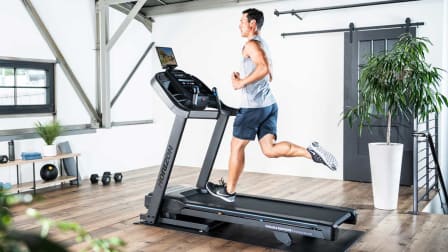Feeling Unsteady? Take These Steps to Improve Your Balance.
Smart ideas to help you avoid falls

While you can slip and fall at any point in life, it’s more common with age. More than 1 out of 4 older adults take a tumble each year, and about 20 percent of these falls lead to injuries such as broken bones, according to the Centers for Disease Control and Prevention.
A host of aging-related changes may be at fault. “We lose muscle strength and flexibility, and our senses become less sharp,” says Anne Vanderbilt, CNS, a nurse practitioner at the Cleveland Clinic’s Center for Geriatric Medicine. Vision and hearing can become less sharp, reducing awareness of fall hazards. Chronic conditions such as arthritis can affect balance, as can certain meds, says Audrey Chun, MD, vice chair of geriatrics and palliative medicine outpatient services with the Mount Sinai Health System in New York City.
Age also affects your vestibular system, the area of your inner ear that helps you maintain balance, says Greg Hartley, DPT, an associate professor of physical therapy at the University of Miami Miller School of Medicine in Coral Gables, Fla.
But there’s plenty that you can do. Consider the following.
Assess Your Steadiness
Four quick “tests” at home can help you gauge your balance, says Richard Marottoli, MD, MPH, medical director of the Dorothy Adler Geriatric Assessment Center at the Yale-New Haven Hospital. Have a sturdy chair or person nearby to hold on to if you need some support.
- Stand in place with your feet together.
- Move one foot forward so that the instep is next to the other foot’s toes.
- Return to the original position, then place the toes of one foot behind the heel of the other foot.
- When back in the original position, stand in place on one leg, then the other.
Ideally, you should be able to hold each move for 10 seconds. If not, or if you have any concerns, tell your doctor. They may refer you to physical therapy or screen you for conditions such as diabetes, stroke, or Parkinson’s disease. And note that your doctor should inquire about balance at annual wellness visits.
How to Improve Your Stability
Review your meds annually. “The most common offenders are those that affect your level of alertness or your blood pressure when standing up,” Marottoli says. These include some medications for high blood pressure; anxiety, such as diazepam (Valium); an overactive bladder, such as oxybutynin (Ditropan); and antihistamines such as diphenhydramine (Benadryl).
Fall-Proof Your Home
Nearly 80 percent of emergency room visits for falls by older adults are the result of accidents that happen at home, according to a 2021 study published in the American Journal of Lifestyle Medicine.
To ensure that your home is as safe as possible, the Centers for Disease Control and Prevention recommends the following steps.
- Keep your floors clutter-free.
- Get rid of throw rugs.
- Add grab bars in the bathroom.
- Install handrails on all staircases.
- Make sure that your home is well lit.
This includes adding lights at the top and bottom of all your staircases and night lights in hallways, especially those that lead to bathrooms.
6 Moves That Center You
Hartley says these are his favorite balance exercises.
- The Standing March: Hold on to your kitchen counter and march in place for a minute. As your balance improves, try this without holding on.
- Sit to Stand: Sit in a sturdy, armless chair and push yourself up to standing. “It improves your lower extremity strength, which is important for good balance,” Hartley says. Do 10 to 15 reps.
- Side Steps: Stand with your feet together and knees slightly bent. Lightly hold on to a kitchen counter if necessary. Step your left foot out to the side and move your right foot to meet it, then do the sequence in the opposite direction. Repeat this three times.
- Three-Way Kick: Lightly hold on to a kitchen counter if necessary, stand on one leg, and slowly raise the other leg in front of you. With the raised leg as straight as possible, lower it down. Do the same move with your leg out to the side and then with your leg behind you. Repeat on the other side.
- Toe Raises: Stand facing a kitchen countertop (hold on to it if necessary) and lift the toes of both feet as high as is comfortable. Then lower them. Repeat 10 to 15 times.
- Heel-Toe Walk: Standing, place the heel of your right foot just in front of the toes of your left foot. Then take a step, placing your left heel just in front of your right foot. Repeat 10 to 15 times. Hold on to a sturdy item for stability.
Editor’s Note: This article also appeared in the February 2024 issue of Consumer Reports On Health.




















